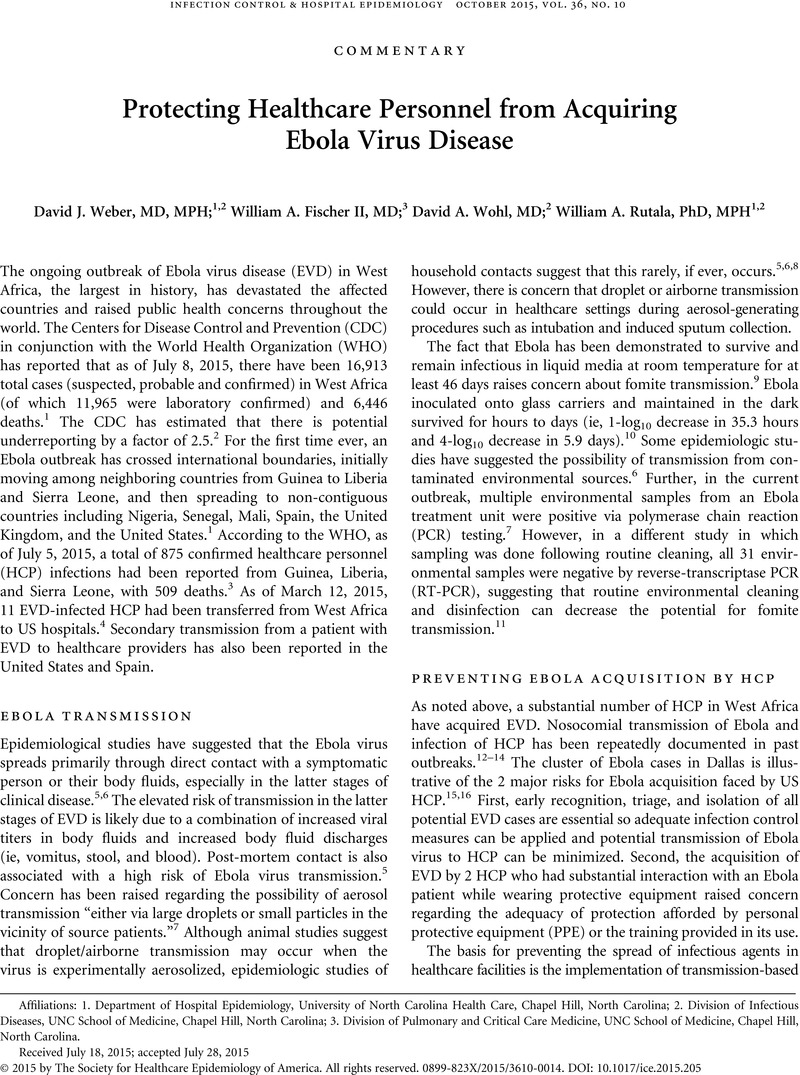Crossref Citations
This article has been cited by the following publications. This list is generated based on data provided by Crossref.
Weber, David J.
Rutala, William A.
Fischer, William A.
Kanamori, Hajime
and
Sickbert-Bennett, Emily E.
2016.
Emerging infectious diseases: Focus on infection control issues for novel coronaviruses (Severe Acute Respiratory Syndrome-CoV and Middle East Respiratory Syndrome-CoV), hemorrhagic fever viruses (Lassa and Ebola), and highly pathogenic avian influenza viruses, A(H5N1) and A(H7N9).
American Journal of Infection Control,
Vol. 44,
Issue. 5,
p.
e91.
Grein, Jonathan D.
and
Murthy, A. Rekha
2016.
Preparing a Hospital for Ebola Virus Disease: a Review of Lessons Learned.
Current Treatment Options in Infectious Diseases,
Vol. 8,
Issue. 4,
p.
237.
Dowall, Stuart D.
Bosworth, Andrew
Rayner, Emma
Taylor, Irene
Landon, John
Cameron, Ian
Coxon, Ruth
Al Abdulla, Ibrahim
Graham, Victoria A.
Hall, Graham
Kobinger, Gary
Hewson, Roger
and
Carroll, Miles W.
2016.
Post-exposure treatment of Ebola virus disease in guinea pigs using EBOTAb, an ovine antibody-based therapeutic.
Scientific Reports,
Vol. 6,
Issue. 1,
Nikiforuk, Aidan M.
Cutts, Todd A.
Theriault, Steven S.
and
Cook, Bradley W. M.
2017.
Challenge of Liquid Stressed Protective Materials and Environmental Persistence of Ebola Virus.
Scientific Reports,
Vol. 7,
Issue. 1,
Kwon, Jennie H.
Burnham, Carey-Ann D.
Reske, Kimberly A.
Liang, Stephen Y.
Hink, Tiffany
Wallace, Meghan A.
Shupe, Angela
Seiler, Sondra
Cass, Candice
Fraser, Victoria J.
and
Dubberke, Erik R.
2017.
Assessment of Healthcare Worker Protocol Deviations and Self-Contamination During Personal Protective Equipment Donning and Doffing.
Infection Control & Hospital Epidemiology,
Vol. 38,
Issue. 9,
p.
1077.
Siegel, Jane D.
and
Guzman-Cottrill, Judith A.
2018.
Principles and Practice of Pediatric Infectious Diseases.
p.
10.
Weber, David J.
Sickbert-Bennett, Emily E.
Kanamori, Hajime
and
Rutala, William A.
2019.
New and emerging infectious diseases (Ebola, Middle Eastern respiratory syndrome coronavirus, carbapenem-resistant Enterobacteriaceae, Candida auris): Focus on environmental survival and germicide susceptibility.
American Journal of Infection Control,
Vol. 47,
Issue. ,
p.
A29.
Andersen, Bjørg Marit
2019.
Prevention and Control of Infections in Hospitals.
p.
1077.
Hilfiker, Lorenz
and
Ganguly, Shashwat
2020.
Integrated Risk of Pandemic: Covid-19 Impacts, Resilience and Recommendations.
p.
21.
Namiki, Takahiro
and
Hayakawa, Satoshi
2020.
Possible importance of carcasses for ebolavirus persistence in the ecosystem.
Medical Hypotheses,
Vol. 138,
Issue. ,
p.
109595.
Sood, Geeta
and
Perl, Trish M.
2021.
Outbreaks in Health Care Settings.
Infectious Disease Clinics of North America,
Vol. 35,
Issue. 3,
p.
631.
Biondi, Mia J.
Garnett, Lauren
Bello, Alexander
Funk, Duane
Poliquin, Philippe Guillaume
Jones, Shane
Tierney, Kevin
Tran, Kaylie
Kozak, Robert A.
Leung, Anders
Grolla, Allen
Nakamura, Cory
Soule, Geoff
Ranadheera, Charlene
Hagan, Mable
Dhaliwal, Amrinder
Kobasa, Darwyn
Falzarano, Darryl
Bovendo, Hugues Fausther
Feldmann, Heinz
Kesselman, Murray
Hansen, Gregory
Gren, Jason
Mortimer, Todd
Racine, Trina
Deschambault, Yvon
Edmonds, Jocelyn
Aminian, Sam
Saurette, Ray
Allan, Mark
Rondeau, Lauren
Huynh, John
Hadder, Sharron
Press, Christy
DeGraff, Christine
Kucas, Stephanie
Kubay, Julie
Azanarsky, Kim
Cook, Bradley W. M.
Hancock, BJ
Kumar, Anand
Soni, Reeni
Schantz, Daryl
McKitrick, Jarrid
Warner, Bryce
Griffin, Bryan D.
Qiu, Xiangguo
Kobinger, Gary P.
Safronetz, Dave
Wood, Heidi
Stein, Derek R.
Cutts, Todd
Pickering, Brad
Kenny, James
Theriault, Steven
Menec, Liam
Vendramelli, Robert
Higgins, Sean
Banadyga, Logan
Liu, Guodong
Rahim, Md Niaz
Kasloff, Samantha
Sloan, Angela
He, Shihua
Tailor, Nikesh
Albietz, Alixandra
Wong, Gary
Gray, Michael
Feldmann, Friederike
Marzi, Andrea
Risi, George
and
Strong, James E.
2021.
Characterization of Ebola Virus Risk to Bedside Providers in an Intensive Care Environment.
Microorganisms,
Vol. 9,
Issue. 3,
p.
498.
Wyer, Mary
Hor, Su-Yin
Barratt, Ruth
and
Gilbert, G L
2021.
Testing the efficacy and acceptability of video-reflexive methods in personal protective equipment training for medical interns: a mixed methods study.
BMJ Open,
Vol. 11,
Issue. 10,
p.
e052985.
Contreras, George W.
Burcescu, Brigitte
Dang, Tiffany
Freeman, Jeanette
Gilbreth, Nathan
Jacobson, Juliet
Jayaseelan, Keerthana
and
Markenson, David S.
2022.
Drawing Parallels Among Past Public Health Crises and COVID-19.
Disaster Medicine and Public Health Preparedness,
Vol. 16,
Issue. 6,
p.
2634.
Lukowski, Joseph
Vasa, Angela
Arguinchona, Christa
ElRayes, Wael
Frank, Maria G
Galdys, Alison L
Garcia, Mary C
Garland, Jennifer A
Kline, Susan
Persson, Caroline
Ruby, Darrell
Sauer, Lauren M
Vasistha, Sami
Carrasco, Sharon
and
Herstein, Jocelyn J
2023.
A narrative review of high-level isolation unit operational and infrastructure features.
BMJ Global Health,
Vol. 8,
Issue. 7,
p.
e012037.



